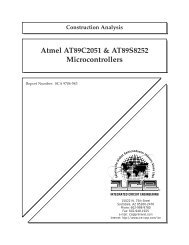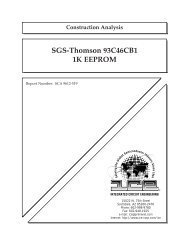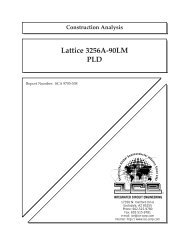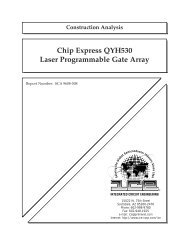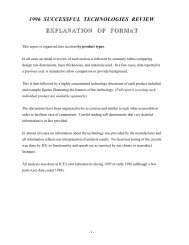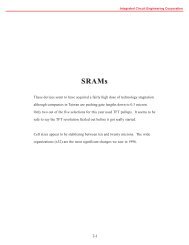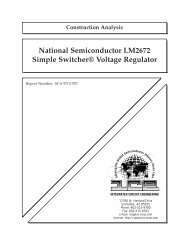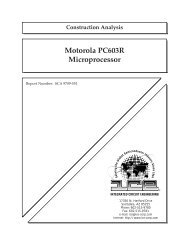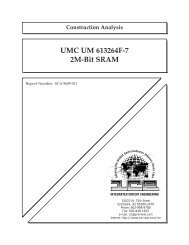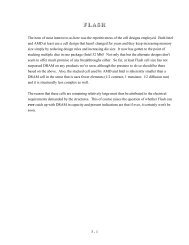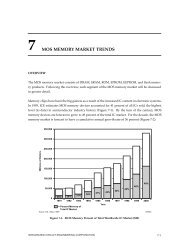Xilinx XC9536 CPLD - Smithsonian - The Chip Collection
Xilinx XC9536 CPLD - Smithsonian - The Chip Collection
Xilinx XC9536 CPLD - Smithsonian - The Chip Collection
You also want an ePaper? Increase the reach of your titles
YUMPU automatically turns print PDFs into web optimized ePapers that Google loves.
Report Number: SCA 9212-568<br />
Construction Analysis<br />
<strong>Xilinx</strong> <strong>XC9536</strong><br />
<strong>CPLD</strong><br />
Serving the Global Semiconductor Industry Since 1964<br />
17350 N. Hartford Drive<br />
Scottsdale, AZ 85255<br />
Phone: 602-515-9780<br />
Fax: 602-515-9781<br />
e-mail: ice@ice-corp.com<br />
Internet: http://www.ice-corp.com<br />
®
TITLE<br />
INDEX TO TEXT<br />
PAGE<br />
INTRODUCTION 1<br />
MAJOR FINDINGS 1<br />
TECHNOLOGY DESCRIPTION<br />
Packaging/Assembly 2<br />
Die Process 2 - 3<br />
ANALYSIS RESULTS I<br />
Assembly 4<br />
ANALYSIS RESULTS II<br />
TABLES<br />
Die Process 5 - 7<br />
Procedure 8<br />
Overall Quality Evaluation 9<br />
Package Markings 10<br />
Die Material Analysis 10<br />
Horizontal Dimensions 11<br />
Vertical Dimensions 12
INTRODUCTION<br />
This report describes a construction analysis of the <strong>Xilinx</strong> <strong>XC9536</strong> <strong>CPLD</strong>. One device<br />
packaged in a 44-pin VQFP (very small quad flat pack) with gull wing leads for surface<br />
mount applications was provided. <strong>The</strong> part was date coded 9633.<br />
Questionable Items: 1<br />
MAJOR FINDINGS<br />
• Metal 2 aluminum thinned up to 100 percent 2 at some vias (Figure 15) and metal 1<br />
aluminum thinned up to 100 percent 2 at some contacts (Figures 21 and 22). Barrier<br />
metal maintained continuity.<br />
Special Features:<br />
• Fast FLASH technology.<br />
• Sub-micron gates (0.45 micron N-channel, 0.5 micron P-channel).<br />
1 <strong>The</strong>se items present possible quality or reliability concerns. <strong>The</strong>y should be discussed<br />
with the manufacturer to determine their possible impact on the intended application.<br />
2 Seriousness depends on design margins.<br />
- 1 -
Packaging/Assembly:<br />
TECHNOLOGY DESCRIPTION<br />
• <strong>The</strong> device was encapsulated in a 44-pin very small quad flat pack with gull wing<br />
leads.<br />
• Lead locking provisions (anchors) at all pins.<br />
• <strong>The</strong>rmosonic ball bond method using gold wire.<br />
• Sawn dicing (full depth).<br />
• Silver (Ag) epoxy die attach.<br />
Die Process:<br />
• Fabrication: Twin-well CMOS, selective oxidation process. P substrate and no epi.<br />
• Final passivation: A layer of silicon-nitride over silicon-dioxide.<br />
• Metallization: Two levels of aluminum interconnect patterned by dry-etch<br />
techniques. A titanium-nitride (TiN) cap and barrier metal were employed with both<br />
metal levels. Standard vias and contacts were employed (no plugs).<br />
• Interlevel dielectric: Two layers of silicon-dioxide. A spin-on-glass (SOG) was<br />
used between these layers for planarization purposes. No evidence of chemical<br />
mechanical planarization (CMP) was present.<br />
• Pre-metal glass: A thick reflow glass over various densified oxides. It appeared to<br />
have been reflowed prior to contact cuts only.<br />
• Polysilicon: Two layers of polysilicon were present. Poly 1 was used exclusively in<br />
the array for floating gates and poly 2 (poly and tungsten silicide) was used for all<br />
standard gates on the die and word and program lines in the array.<br />
- 2 -
TECHNOLOGY DESCRIPTION (continued)<br />
• Diffusions: Transistors were formed using an LDD process in which the oxide sidewall<br />
spacers were left in place. Implanted N+ and P+ sources/drains. No silicide was used at<br />
diffusions.<br />
• Twin-wells were used in a P substrate. No epi was present. A step was present in the<br />
oxide at the well boundaries.<br />
• No buried contacts were employed on this device.<br />
• Memory cells: <strong>The</strong> programmable array consisted of EEPROM cells (Fast FLASH<br />
technology). Metal 2 was used to form "piggyback" word and program lines.<br />
Metal 1 distributed the bit lines and GND. Poly 2 formed the word and program<br />
lines and poly 1 formed the floating gates. <strong>The</strong> interpoly dielectric consisted of<br />
ONO (oxide-nitride-oxide).<br />
• Design features: Metal 2 bus lines were slotted for stress relief. Some isolated vias<br />
were present on the die which may be used for probing purposes (see Figure 4).<br />
- 3 -
Assembly :<br />
Questionable Items: None.<br />
General Items:<br />
ANALYSIS RESULTS I<br />
• 44-pin VQFP plastic packages with gull wing leads.<br />
- 4 -<br />
Figures 1 and 6<br />
• Overall package quality: Normal. No defects were found on the external portions of<br />
the package.<br />
• Leadframe: Lead-locking provisions (anchors) were present at all pins.<br />
• Die attach: <strong>The</strong> die was attached to the header with silver-epoxy of normal quality.<br />
• Die dicing: Die separation was by sawing with normal quality workmanship. No<br />
cracks or large chipouts were found in the die.<br />
• Wirebonding: <strong>The</strong>rmosonic ball bond method using gold wire. Bonds were well<br />
formed and placement was good. Bond pad pitch was tight (117 microns);<br />
however, no problems were noted and wire spacing was good. Bond pad structure<br />
employed both metals.
Die Process :<br />
Questionable Items: 1<br />
ANALYSIS RESULTS II<br />
2Seriousness depends on design margins.<br />
- 5 -<br />
Figures 2 - 37<br />
• Metal 2 aluminum thinned up to 100 percent 2 at some vias (Figure 15) and metal 1<br />
aluminum thinned up to 100 percent 2 at some contacts (Figures 21 and 22). Barrier<br />
metal maintained continuity.<br />
Special Features:<br />
• Fast FLASH technology.<br />
• Sub-micron gates (0.45 micron N-channel, 0.5 micron P-channel).<br />
General Items:<br />
• Fabrication process: Selective oxidation CMOS process using twin-wells in a P<br />
substrate. No epi was present.<br />
• Process Implementation: Die layout was clean and efficient. Alignment/registration<br />
was good at all levels and no damage or contamination was found.<br />
• Final passivation: A layer of silicon-nitride over silicon-dioxide. Passivation<br />
extended into the scribe lane covering all metallization. A cutout was present in the<br />
passivation around the die perimeter in the scribe lane. This was probably employed<br />
to prevent cracks from radiating inward.<br />
• Metallization: Two levels of aluminum interconnect. A titanium-nitride (TiN) cap<br />
and barrier metal were employed with each metal level. Standard vias and contacts<br />
were employed (no plugs).<br />
1 <strong>The</strong>se items present possible quality or reliability concerns. <strong>The</strong>y should be discussed<br />
with the manufacturer to determine their possible impact on the intended application.
ANALYSIS RESULTS II (continued)<br />
• Metal patterning: Both layers were defined by dry-etch techniques. Definition was<br />
normal for both layers. Some neckdown of metal 2 lines was noted where they<br />
crossed over metal 1 lines. Metal lines were widened at vias and contacts.<br />
• Metal defects: No voiding or notching of the metals was found. No silicon nodules<br />
were found following the removal of the aluminum layers. No problems were<br />
noted.<br />
• Metal step coverage: Metal 2 aluminum thinned up to 100 percent at some via<br />
edges. Metal 1 aluminum also thinned up to 100 percent at some contact edges.<br />
Barrier metal maintained continuity. <strong>The</strong> excessive thinning appears to be due to the<br />
metal deposition method employed.<br />
• Vias and contacts: Metal 2 vias were overetched into the metal 1 cap; however, no<br />
problems are foreseen. No overetching of metal 1 contacts was noted.<br />
• Interlevel dielectric: <strong>The</strong> dielectric between the two metal levels consisted of two<br />
layers of silicon-dioxide with a spin-on-glass (SOG) employed between for<br />
planarization purposes. No problems were noted.<br />
• Pre-metal glass: <strong>The</strong> glass under metal 1 consisted of a thick reflow glass which<br />
was apparently reflowed prior to contact cuts only. This deposited glass was located<br />
over various densified oxides. No problems were found in any of the glass layers.<br />
• Polysilicon: Two layers of poly were used. Polycide (tungsten silicide on poly 2)<br />
formed all standard gates on the die. Poly 1 was used exclusively for floating gates<br />
in the array. No poly stringers or spurs were present. Definition was by a dry etch<br />
of good quality.<br />
• Isolation: Local oxide (LOCOS). No problems were present at the birdsbeak. A<br />
step was present in the field oxide indicating a twin-well process was used.<br />
- 6 -
ANALYSIS RESULTS II (continued)<br />
• Diffusions: Transistors were formed using an LDD process in which the oxide<br />
sidewall spacers were left in place. Implanted N+ and P+ sources/drains were<br />
employed. Definition was normal and no problems were present. Diffusions were<br />
not silicided.<br />
• Wells: Twin-wells in a P substrate. No problems were apparent.<br />
• Epi: No epi was used. No substrate defects were found.<br />
• Buried contacts: No buried contacts were used on this device.<br />
• Memory cells: <strong>The</strong> programmable array consisted of EEPROM cells (Fast FLASH<br />
technology). Metal 2 was used to form "piggyback" word and program lines.<br />
Metal 1 formed the bit lines and distributed GND. Poly 2 formed the word and<br />
program lines and poly 1 formed the floating gates. <strong>The</strong> interpoly dielectric<br />
consisted of ONO (oxide-nitride-oxide). Cell size was 5.2 x 6 microns and cell area<br />
was 31 microns 2 .<br />
- 7 -
PROCEDURE<br />
<strong>The</strong> devices were subjected to the following analysis procedures:<br />
External inspection<br />
X-ray<br />
Decapsulate<br />
Internal optical inspection<br />
Passivation removal and inspect metal 2<br />
Metal 2 removal and inspect barrier<br />
Delayer to metal 1 and inspect<br />
Aluminum 1 removal and inspect barrier<br />
Delayer to poly/substrate and inspect poly structures and die surface<br />
Die material analysis<br />
Die sectioning (90° for SEM) *<br />
Measure horizontal dimensions<br />
Measure vertical dimensions<br />
* Delineation of cross-sections is by silicon etch unless otherwise indicated.<br />
- 8 -
OVERALL QUALITY EVALUATION: Overall Rating: Normal/Poor<br />
DETAIL OF EVALUATION<br />
Package integrity N<br />
Die placement G<br />
Die attach quality N<br />
Wire spacing G<br />
Wirebond placement G<br />
Wirebond quality N<br />
Dicing quality G<br />
Die attach method Silver-epoxy<br />
Dicing method Sawn (full depth)<br />
Die surface integrity:<br />
Tool marks (absence) G<br />
Particles (absence) G<br />
Contamination (absence) G<br />
Process defects (absence) G<br />
General workmanship N<br />
Passivation integrity G<br />
Metal definition N<br />
Metal integrity P *<br />
Metal registration G<br />
Contact coverage G<br />
Contact registration G<br />
* Metal 2 and metal 1 aluminum thinning up to 100 percent.<br />
G = Good, P = Poor, N = Normal, NP = Normal/Poor<br />
- 9 -
TOP<br />
PACKAGE MARKINGS<br />
- 10 -<br />
BOTTOM (molded)<br />
(logo) XILINX® KOREA 23<br />
<strong>XC9536</strong><br />
VQ44ASJ9633<br />
A63042A 7C B(penciled)<br />
DIE MATERIAL ANALYSIS<br />
Final passivation: Silicon-nitride over silicon-dioxide.<br />
Metallization 2: Aluminum with a titanium-nitride cap and barrier metal.<br />
Interlevel dielectric: Two layers of silicon-dioxide with a spin-on glass.<br />
Metallization 1: Aluminum with a titanium-nitride cap and barrier metal.<br />
Intermediate glass: Reflow glass.<br />
Polycide: Tungsten on poly 2.
HORIZONTAL DIMENSIONS<br />
Die size: 3.4 x 5.6 mm (134 x 222 mils)<br />
Die area: 19.2 mm 2 (29,748 mils 2 )<br />
Min pad size: 0.11 x 0.11 mm (4.3 x 4.3 mils)<br />
Min pad window: 0.09 x 0.09 mm (3.7 x 3.7 mils)<br />
Min pad space: 8 microns<br />
Min metal 2 width: 0.8 micron<br />
Min metal 2 space: 1.0 micron<br />
Min metal 2 pitch (uncontacted): 1.9 micron<br />
Min metal 2 pitch (contacted): 2.6 microns<br />
Min via: 1.0 micron (round)<br />
Min via pitch: 2.0 microns<br />
Min metal 1 width: 0.55 micron<br />
Min metal 1 space: 0.9 micron<br />
Min metal 1 pitch (uncontacted): 1.6 micron<br />
Min metal 1 pitch (contacted): 2.5 microns<br />
Min contact: 1.0 micron<br />
Min contact pitch: 1.7 micron<br />
Min contact-to-gate: 0.6 micron<br />
Min poly 2 width: 0.45 micron<br />
Min poly 2 space: 0.85 micron<br />
Min poly 1 width: 0.65 micron<br />
Min gate length * (N-ch): 0.45 micron<br />
(P-ch): 0.5 micron<br />
Cell pitch: 5.2 x 6 microns<br />
Cell size: 31 microns 2<br />
* Physical gate length.<br />
- 11 -
VERTICAL DIMENSIONS<br />
Die thickness: 0.4 mm (16 mils)<br />
Layers:<br />
Passivation 2: 0.45 micron<br />
Passivation 1: 0.25 micron<br />
Metallization 2 - cap: 0.05 micron (approx.)<br />
- aluminum: 0.75 micron<br />
- barrier: 0.1 micron<br />
Interlevel dielectric: 0.65 - 1.9 micron<br />
Metallization 1 - cap: 0.07 micron<br />
- aluminum: 0.5 micron<br />
- barrier: 0.1 micron<br />
Pre-metal glass: 0.35 - 0.9 micron<br />
Polycide - silicide: 0.13 micron<br />
- poly 2: 0.1 micron<br />
Poly 1: 0.1 micron<br />
Local oxide: 0.5 micron<br />
N+ S/D: 0.17 micron<br />
P+ S/D: 0.2 micron<br />
N-well: 4.0 microns<br />
- 12 -
INDEX TO FIGURES<br />
PACKAGE PHOTOGRAPH AND X-RAY Figure 1<br />
DIE LAYOUT AND IDENTIFICATION Figures 2 - 5<br />
PHYSICAL DIE STRUCTURES Figures 6 - 37<br />
CROSS SECTION DRAWING Figure 30<br />
MEMORY CELL Figures 31 - 37
<strong>Xilinx</strong> <strong>XC9536</strong><br />
PIN 1<br />
Integrated Circuit Engineering Corporation<br />
Figure 1. Package photograph and x-ray view of the <strong>Xilinx</strong> <strong>XC9536</strong>. Mag. 6x.
<strong>Xilinx</strong> <strong>XC9536</strong><br />
Figure 2. Whole die photograph of the <strong>Xilinx</strong> <strong>XC9536</strong>. Mag. 40x.<br />
Integrated Circuit Engineering Corporation
Figure 3. Die identification markings. Mag. 400x.<br />
<strong>Xilinx</strong> <strong>XC9536</strong><br />
Integrated Circuit Engineering Corporation
<strong>Xilinx</strong> <strong>XC9536</strong><br />
Mag. 400x<br />
Mag. 800x<br />
ISOLATED VIAS<br />
Figure 4. Optical views illustrating design features.<br />
Integrated Circuit Engineering Corporation<br />
SLOTS
<strong>Xilinx</strong> <strong>XC9536</strong><br />
Figure 5. Optical views of die corners. Mag. 160x.<br />
Integrated Circuit Engineering Corporation<br />
DAMAGED DURING<br />
REMOVAL
<strong>Xilinx</strong> <strong>XC9536</strong><br />
METAL 2<br />
METAL 2<br />
METAL 1<br />
CUTOUT<br />
123<br />
SUBSTRATE<br />
Mag. 2600x<br />
PASSIVATION 2<br />
PASSIVATION 1<br />
Mag. 10,300x<br />
Figure 6. SEM section views of the edge seal structure.<br />
P+<br />
EDGE OF DIE<br />
Integrated Circuit Engineering Corporation
<strong>Xilinx</strong> <strong>XC9536</strong><br />
PAD WINDOW<br />
METAL 2 PAD<br />
METAL 1<br />
PASSIVATION 2<br />
METAL 2 BOND PAD<br />
METAL 1<br />
PASSIVATION 1<br />
Integrated Circuit Engineering Corporation<br />
Au BOND<br />
Mag. 320x<br />
Mag. 2200x<br />
Mag. 7700x<br />
Figure 7. Topological and section views of the bond pad layout and structure.
<strong>Xilinx</strong> <strong>XC9536</strong><br />
LOCAL OXIDE<br />
POLY 2 GATE<br />
METAL 1<br />
METAL 2<br />
METAL 2<br />
Mag. 7900x<br />
PASSIVATION 2<br />
ILD<br />
PASSIVATION 1<br />
Mag. 9600x<br />
PASSIVATION 2<br />
SOG<br />
METAL 1<br />
N+ S/D P+<br />
Figure 8. SEM section views illustrating general device structure.<br />
Integrated Circuit Engineering Corporation<br />
POLY 2 GATES<br />
N+ S/D
<strong>Xilinx</strong> <strong>XC9536</strong><br />
SOG<br />
PASSIVATION 2<br />
ILD<br />
METAL 1<br />
PASSIVATION 1<br />
LOCAL OXIDE<br />
METAL 1<br />
Mag. 7600x<br />
PASSIVATION 2<br />
METAL 2<br />
POLY 2<br />
Mag. 9000x<br />
METAL 2<br />
POLY 2<br />
SOG<br />
Figure 9. Glass etch section views illustrating general device structure.<br />
Integrated Circuit Engineering Corporation
<strong>Xilinx</strong> <strong>XC9536</strong><br />
PASSIVATION 2<br />
PASSIVATION 1<br />
METAL 2<br />
TiN CAP<br />
PASSIVATION 2<br />
METAL 2<br />
ILD<br />
METAL 1<br />
PRE-METAL DIELECTRIC<br />
ILD<br />
Ti ADHESION LAYER<br />
POLY 2<br />
PASSIVATION 2<br />
PASSIVATION 1<br />
ALUMINUM 2<br />
TiN BARRIER<br />
Figure 10. SEM section views of metal 2 line profiles.<br />
Integrated Circuit Engineering Corporation<br />
Mag. 15,500x<br />
Mag. 26,250x<br />
Mag. 34,000x
<strong>Xilinx</strong> <strong>XC9536</strong><br />
METAL 2 VIAS<br />
Figure 11. Topological SEM views of metal 2 patterning. Mag. 5500x, 0°.<br />
Integrated Circuit Engineering Corporation
METAL 2<br />
METAL 2<br />
NECKDOWN<br />
VIA<br />
METAL 2<br />
Figure 12. Topological SEM views of metal 2 design rule features. Mag. 13,000x, 0°.<br />
VIAS<br />
VIAS<br />
<strong>Xilinx</strong> <strong>XC9536</strong><br />
Integrated Circuit Engineering Corporation
<strong>Xilinx</strong> <strong>XC9536</strong><br />
BARRIER<br />
Mag. 6000x<br />
Mag. 25,000x<br />
ALUMINUM 2<br />
Figure 13. SEM views of general metal 2 integrity. 60°.<br />
Integrated Circuit Engineering Corporation
<strong>Xilinx</strong> <strong>XC9536</strong><br />
TiN BARRIER<br />
VIAS<br />
Mag. 15,000x, 0°<br />
Mag. 31,000x, 55°<br />
Figure 14. SEM views of metal 2 barrier.<br />
Integrated Circuit Engineering Corporation<br />
TiN BARRIER
PASSIVATION 1<br />
METAL 2<br />
PASSIVATION 2 PASSIVATION 1<br />
METAL 2<br />
METAL 1<br />
PRE-METAL DIELECTRIC<br />
Mag. 14,000x<br />
100% THINNING<br />
METAL 1<br />
Mag. 30,000x<br />
VOID<br />
ILD<br />
METAL 2<br />
Figure 15. SEM section views of metal 2-to-metal 1 vias.<br />
METAL 2<br />
METAL 1<br />
PASSIVATION 1<br />
PRE-METAL DIELECTRIC<br />
Mag. 14,600x<br />
100% THINNING<br />
METAL 1<br />
VOID<br />
Mag. 30,000x<br />
PASSIVATION 2<br />
ILD<br />
ILD<br />
<strong>Xilinx</strong> <strong>XC9536</strong><br />
Integrated Circuit Engineering Corporation
<strong>Xilinx</strong> <strong>XC9536</strong><br />
TiN CAP<br />
ALUMINUM 1<br />
TiN BARRIER<br />
PASSIVATION 2<br />
METAL 1<br />
PRE-METAL DIELECTRIC<br />
LOCAL OXIDE<br />
Mag. 18,300x<br />
SOG<br />
Mag. 37,300x<br />
SOG<br />
Figure 16. SEM section views of metal 1 line profiles.<br />
ILD<br />
Integrated Circuit Engineering Corporation
<strong>Xilinx</strong> <strong>XC9536</strong><br />
Mag. 4000x<br />
Mag. 6000x<br />
CONTACTS<br />
METAL 1<br />
Figure 17. Topological SEM views of metal 1 patterning. 0°.<br />
Integrated Circuit Engineering Corporation
<strong>Xilinx</strong> <strong>XC9536</strong><br />
METAL 1<br />
CONTACT<br />
CONTACTS<br />
Figure 18. Topological SEM views of metal 1 design rule features. 0°.<br />
Integrated Circuit Engineering Corporation<br />
Mag. 26,000x<br />
Mag. 13,000x<br />
Mag. 13,000x
<strong>Xilinx</strong> <strong>XC9536</strong><br />
TiN CAP<br />
ALUMINUM 1<br />
TiN BARRIER<br />
Figure 19. SEM views of general metal 1 integrity. 55°.<br />
Integrated Circuit Engineering Corporation<br />
Mag. 5500x<br />
Mag. 9000x<br />
Mag. 27,000x
<strong>Xilinx</strong> <strong>XC9536</strong><br />
CONTACTS<br />
TiN BARRIER<br />
Mag. 26,000x, 0°<br />
Mag. 20,000x, 55°<br />
TiN BARRIER<br />
Figure 20. SEM views of metal 1 barrier.<br />
Integrated Circuit Engineering Corporation
<strong>Xilinx</strong> <strong>XC9536</strong><br />
PRE-METAL<br />
DIELECTRIC<br />
POLY 2<br />
GATE<br />
N+ S/D<br />
METAL 1<br />
N+ S/D<br />
SOG<br />
SOG<br />
ILD<br />
ILD<br />
METAL 1<br />
100% THINNING<br />
METAL 1<br />
POLY 2<br />
LOCAL OXIDE<br />
100% THINNING<br />
POLY 2<br />
LOCAL OXIDE<br />
Figure 21. SEM section views of metal 1 contacts.<br />
Integrated Circuit Engineering Corporation<br />
PRE-METAL<br />
DIELECTRIC<br />
Mag. 19,500x<br />
Mag. 27,400x<br />
Mag. 29,300x
POLY 2<br />
METAL 1<br />
ILD<br />
METAL 1<br />
LOCAL OXIDE<br />
Mag. 20,500x<br />
SOG<br />
ILD<br />
Mag. 23,000x<br />
POLY 2<br />
SOG<br />
LOCAL OXIDE<br />
N+ S/D N+ S/D<br />
POLY 2<br />
Figure 22. SEM section views illustrating metal 1 contact spacings.<br />
ILD<br />
SOG<br />
METAL 1<br />
P+<br />
Mag. 23,300x<br />
ILD<br />
METAL 1<br />
N+<br />
Mag. 20,500x<br />
SOG<br />
<strong>Xilinx</strong> <strong>XC9536</strong><br />
Integrated Circuit Engineering Corporation
<strong>Xilinx</strong> <strong>XC9536</strong><br />
POLY 2<br />
GATES<br />
POLY 2 GATES<br />
Figure 23. Topological SEM views of poly patterning. Mag. 4000x, 0°.<br />
Integrated Circuit Engineering Corporation
<strong>Xilinx</strong> <strong>XC9536</strong><br />
CONTACT<br />
POLY 2<br />
POLY 2<br />
CONTACT<br />
POLY 2<br />
CONTACT<br />
Figure 24. Topological SEM views of poly design rule features.<br />
Integrated Circuit Engineering Corporation<br />
Mag. 13,000x<br />
Mag. 26,000x<br />
Mag. 26,000x
<strong>Xilinx</strong> <strong>XC9536</strong><br />
POLY 2 GATE<br />
DIFFUSION<br />
POLY 2 GATE<br />
Figure 25. Perspective SEM views of poly coverage. 55°.<br />
Integrated Circuit Engineering Corporation<br />
DIFFUSION<br />
Mag. 5000x<br />
Mag. 9000x<br />
Mag. 25,000x
<strong>Xilinx</strong> <strong>XC9536</strong><br />
PASSIVATION 2<br />
METAL 1<br />
N+ S/D<br />
N+ S/D<br />
ILD<br />
METAL 1<br />
N+ S/D<br />
METAL 1<br />
ILD<br />
POLY 2 GATES<br />
POLY 2 GATE<br />
POLY 2 GATE<br />
PRE-METAL DIELECTRIC<br />
GATE OXIDE<br />
SOG<br />
Figure 26. SEM section views of N-channel transistors.<br />
Integrated Circuit Engineering Corporation<br />
Mag. 14,600x<br />
Mag. 17,700x<br />
Mag. 31,500x
<strong>Xilinx</strong> <strong>XC9536</strong><br />
P+ S/D<br />
METAL 1<br />
POLY 2 GATE PRE-METAL<br />
DIELECTRIC<br />
P+ S/D<br />
SOG<br />
POLY 2 GATE<br />
GATE OXIDE<br />
W SILICIDE<br />
POLY 2<br />
GATE OXIDE<br />
Figure 27. SEM section views of P-channel transistors.<br />
Integrated Circuit Engineering Corporation<br />
PRE-METAL<br />
DIELECTRIC<br />
P+ S/D<br />
SIDEWALL<br />
SPACER<br />
Mag. 22,200x<br />
Mag. 42,000x<br />
Mag. 61,000x
<strong>Xilinx</strong> <strong>XC9536</strong><br />
PRE-METAL<br />
DIELECTRIC<br />
METAL 1<br />
METAL 1<br />
STEP<br />
METAL 2<br />
SOG<br />
POLY 2 GATE<br />
N+<br />
N+ S/D<br />
N+ S/D<br />
Figure 28. SEM section views of the I/O structure.<br />
Integrated Circuit Engineering Corporation<br />
POLY 2<br />
PRE-METAL<br />
DIELECTRIC<br />
Mag. 7500x<br />
Mag. 23,200x<br />
Mag. 30,000x
GATE OXIDE<br />
LOCAL OXIDE<br />
POLY 2<br />
LOCAL OXIDE<br />
Mag. 36,400x<br />
Mag. 41,200x<br />
POLY 2<br />
GATE OXIDE<br />
Figure 29. SEM section views of local oxide and well structure.<br />
P+<br />
STEP<br />
METAL 1<br />
Mag. 25,300x<br />
P SUBSTRATE<br />
Mag. 800x<br />
N-WELL<br />
N+<br />
<strong>Xilinx</strong> <strong>XC9536</strong><br />
Integrated Circuit Engineering Corporation
PASSIVATION 2<br />
,,,,,,,,,,,,,,,,,,<br />
INTERLEVEL DIELECTRIC<br />
,,,,,,,,,,,,,,,,,,<br />
,,,,,,,,,,,,,,,,,,<br />
,,,,,,,,,,,,,,,,,,<br />
,,,,,,,,,,<br />
,,,,,,,,,,<br />
P-WELL<br />
PASSIVATION 1<br />
SILICDE<br />
N+ S/D<br />
PRE-METAL GLASS<br />
LOCAL OXIDE<br />
P SUBSTRATE<br />
METAL 2<br />
METAL 1<br />
N-WELL<br />
Orange = Nitride, Blue = Metal, Yellow = Oxide, Green = Poly,<br />
Red = Diffusion, and Gray = Substrate<br />
Figure 30. Color cross section drawing illustrating device structure.<br />
,,,,,,,,,,,,,<br />
,,,,,,,,,,,,,<br />
,,,,,,,,,,,,,<br />
P+ S/D<br />
POLY 2<br />
SOG<br />
<strong>Xilinx</strong> <strong>XC9536</strong><br />
Integrated Circuit Engineering Corporation
<strong>Xilinx</strong> <strong>XC9536</strong><br />
“PIGGYBACK”<br />
PROGRAM<br />
LINES<br />
PROGRAM<br />
LINES<br />
“PIGGYBACK”<br />
PROGRAM LINES<br />
“PIGGYBACK”<br />
WORD LINES<br />
“PIGGYBACK”<br />
WORD LINES<br />
WORD<br />
LINES<br />
Integrated Circuit Engineering Corporation<br />
metal 2<br />
metal 1<br />
poly 2<br />
Figure 31. Topological SEM views of the EEPROM array illustrating “piggyback” word<br />
line connections. Mag. 5000x, 0°.
<strong>Xilinx</strong> <strong>XC9536</strong><br />
“PIGGYBACK”<br />
LINES<br />
WORD<br />
LINES<br />
BIT LINES<br />
“PIGGYBACK”<br />
CONTACTS<br />
PROGRAM<br />
LINES<br />
Integrated Circuit Engineering Corporation<br />
metal 2<br />
metal 1<br />
poly 2<br />
Figure 32. Perspective SEM views of the EEPROM array. Mag. 4000x, 55°.
<strong>Xilinx</strong> <strong>XC9536</strong><br />
POLY 1<br />
POLY 2 PROGRAM<br />
POLY 2 PROGRAM<br />
POLY 1<br />
FLOATING GATE<br />
Figure 33. SEM detail views of EEPROM cells. 55°.<br />
Integrated Circuit Engineering Corporation<br />
Mag. 10,000x<br />
Mag. 24,000x<br />
Mag. 24,000x
“PIGGYBACK” LINES<br />
metal 2<br />
GND<br />
BIT<br />
metal 1<br />
poly<br />
Figure 34. Topological SEM views of EEPROM cells and schematic. Mag. 5000x, 0°.<br />
GND<br />
Q2 Q1<br />
BIT<br />
WORD<br />
PGM<br />
SELECT<br />
GATE<br />
BIT<br />
Q1<br />
Q2<br />
<strong>Xilinx</strong> <strong>XC9536</strong><br />
Integrated Circuit Engineering Corporation
BIT CONTACT<br />
N+ S/D<br />
POLY 2 SELECT<br />
GATE<br />
“PIGGYBACK” LINES<br />
10,500x<br />
PRE-METAL<br />
DIELECTRIC<br />
Mag. 22,500x<br />
POLY 2<br />
POLY 1<br />
POLY 1<br />
FLOATING GATE<br />
POLY 2<br />
PROGRAM<br />
N+ S/D<br />
N+ S/D<br />
POLY 2<br />
GATE OXIDE<br />
Mag. 47,000x<br />
Mag. 21,000x<br />
Figure 35. SEM section views of an EEPROM cell (perpendicular to word line).<br />
METAL 1 BIT<br />
CONTACT<br />
SOG<br />
POLY 2 SELECT<br />
GATE<br />
N+ S/D<br />
SOG<br />
<strong>Xilinx</strong> <strong>XC9536</strong><br />
Integrated Circuit Engineering Corporation
<strong>Xilinx</strong> <strong>XC9536</strong><br />
POLY 1<br />
FLOATING GATE<br />
N+ S/D<br />
POLY 2<br />
GATE OXIDE<br />
W SILICIDE<br />
POLY 2<br />
POLY 1<br />
W SILICIDE<br />
POLY 2<br />
POLY 1<br />
NITRIDE<br />
NITRIDE<br />
Integrated Circuit Engineering Corporation<br />
NITRIDE<br />
Mag. 59,000x<br />
glass etch,<br />
Mag. 59,000x<br />
glass etch,<br />
Mag. 117,500x<br />
Figure 36. Detail views of EEPROM floating gate structure (perpendicular to word lines).
<strong>Xilinx</strong> <strong>XC9536</strong><br />
LOCAL OXIDE<br />
POLY 2<br />
LOCAL OXIDE<br />
LOCAL OXIDE<br />
POLY 2<br />
POLY 1<br />
METAL 2<br />
METAL 1<br />
PASSIVATION 2<br />
PRE-METAL<br />
DIELECTRIC<br />
POLY 1 FLOATING<br />
GATE<br />
POLY 2<br />
PROGRAM<br />
LINE<br />
POLY 1<br />
ONO<br />
Figure 37. SEM section views of EEPROM cells (parallel to word line).<br />
Integrated Circuit Engineering Corporation<br />
Mag. 13,000x<br />
Mag. 26,000x<br />
Mag. 52,000x



